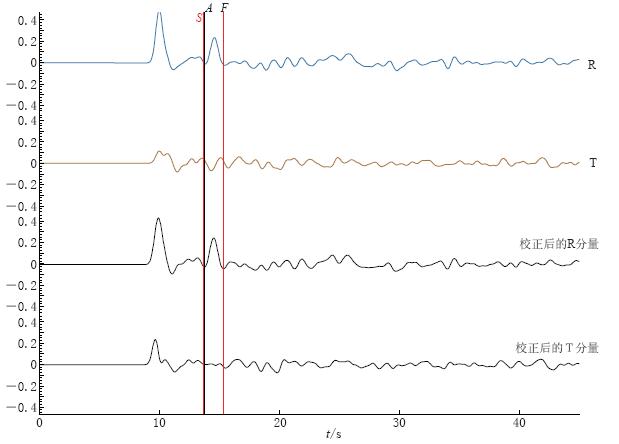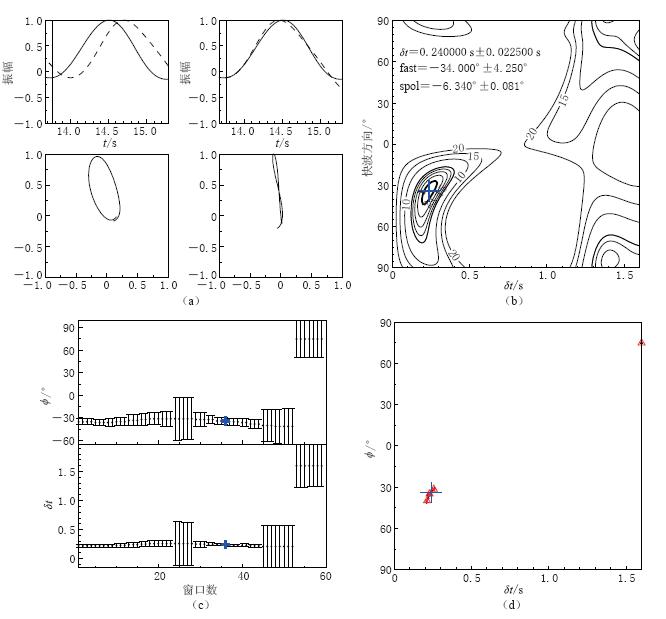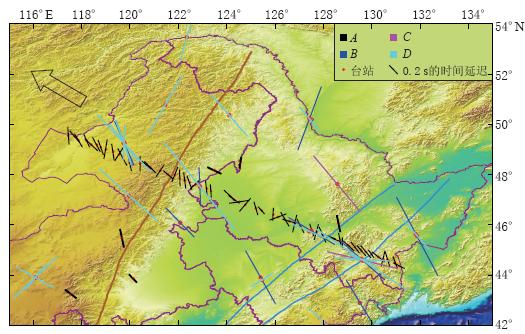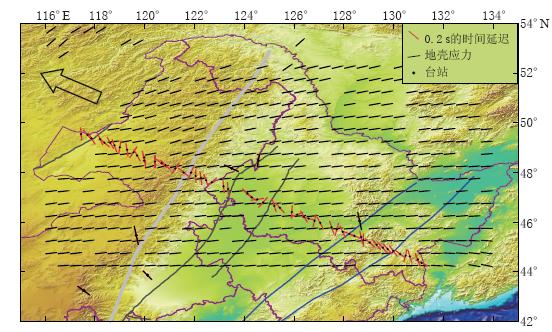An investigation on crustal anisotropy of Northeast China using Moho Ps converted phase
-
摘要: 利用中国东北地区布设的65套宽频带数字地震仪2009年6月—2011年6月记录的远震事件, 用时间域最大熵谱反褶积方法提取接收函数, 并用改进的剪切波分裂分析方法对该区地壳介质各向异性参数进行研究, 获得了该区地壳介质各向异性图像. 结果表明, 该区地壳介质各向异性快波偏振方向大致为北西向, 快慢波时间延迟在0.15—0.3 s之间; 但有7个台站下方地壳各向异性快波方向表现为北东向, 可能与当地复杂构造有关. 该区地壳各向异性快波偏振方向与主压应力场方向近乎垂直, 与板块移动方向基本一致, 与SKS/SKKS各向异性快波方向也基本一致. 推断本研究区地壳介质各向异性反映了该区的主张应力方向, 且主要各向异性来源于中下地壳, 暗示了壳-幔垂直变形的一致性.Abstract: Using teleseismic events recorded by 65 broad-band digital seismic stations during June 2009 to June 2011 in Northeast China, we calculated receiver functions by conducting maximum entropy deconvolution in time domain, and obtained the crustal anisotropy parameters by using the improved shear-wave splitting analysis. The result shows that in Northeast China, the dominant direction of fast wave polarity is approximately in NW--SE in this region, and the time delay between the fast and slow waves is 0.15—0.3 seconds. But the fast wave polarity direction is in NE--SW beneath other 7 stations, possibly due to the effect of local complex structure. Through a comparison study we find that the polarization direction of the fast wave is nearly perpendicular to the direction of principal compressive stress, and is approximately the same as the direction of the Eurasian plate movement and the result of SKS/SKKS analysis. It can be concluded that our result has revealed the tensile stress and the anisotropy may come from the middle and lower part of the crust in this region.
-
Keywords:
- Northeast China /
- crustal anisotropy /
- Moho converted Ps /
- shear-wave splitting
-
引言
中国东北地区地处兴蒙造山带的东部, 东临西太平洋边缘海, 南接华北克拉通. 作为太平洋俯冲带的弧后地区, 该区不仅深源地震频繁发生, 也是火山活动最强烈的地区之一, 是研究大洋板块俯冲带动力学的理想场所之一(图1).
![]() 图 1 鸭绿江—春阳断裂;F2: 敦化—密山断裂; F3: 伊通—依兰断裂; F4: 农安—哈尔滨断裂;F5: 嫩江—八里汗断裂; F6: 得尔布干—额尔古纳断裂. 虚线为缝合带, 红点为台站, 八角星为城市Figure 1. Schematic map of faults in study areaF1: Yalujiang- -Chunyang fault;F2: Dunhua- -Mishan fault;F3: Yitong- -Yilan fault;F4: Nongan- -Harbin fault;F5: Nenjiang- -Balihan fault; F6: Derbugan- -Ergun fault. Dashed lines denote the suture zone,red dots represent seismic stations, stars represent cities
图 1 鸭绿江—春阳断裂;F2: 敦化—密山断裂; F3: 伊通—依兰断裂; F4: 农安—哈尔滨断裂;F5: 嫩江—八里汗断裂; F6: 得尔布干—额尔古纳断裂. 虚线为缝合带, 红点为台站, 八角星为城市Figure 1. Schematic map of faults in study areaF1: Yalujiang- -Chunyang fault;F2: Dunhua- -Mishan fault;F3: Yitong- -Yilan fault;F4: Nongan- -Harbin fault;F5: Nenjiang- -Balihan fault; F6: Derbugan- -Ergun fault. Dashed lines denote the suture zone,red dots represent seismic stations, stars represent cities数十年来, 以火山活动、 深源地震、 盆地形成及俯冲板块归宿等作为研究目标, 地学工作者开展了大量的关于深部结构与壳-幔变形方面的研究, 取得了一系列成果(高原, 1995, 1999; 高原, 滕吉文, 2005; 王良书等, 2005; 石玉涛等, 2006; 彭艳菊等, 2007), 为研究大洋板块俯冲带动力学及解释中国东北地区新生代火山、 现代深源地震的地球动力学机制提供了重要的深部证据. 其中地震波各向异性是研究地球内部形变的重要方法之一. Li和Niu(2010)以及常利军等(2009)采用剪切波分裂方法, 得到了东北地区 台站下方上地幔的各向异性参数, 进一步探讨了浅表地质构造与深部结构之间的关系. 然而在上述研究中, 研究人员忽略了地壳各向异性的影响. 已有研究(McNamara, Owens, 1993; Gao et al, 1994; Liu et al, 2001, 2008a,2008b; 吴晶等, 2007; Zhang et al, 2009; 太龄雪等, 2011)表明, 即使在地壳厚度不大的地区(如中国华北地区、 美国盆山地区)也存在明显的地壳各向异性. 当地幔与地壳各向异性层的对称轴方向相差较大时, 会给剪切波分裂结果造成很大的影响, 因此地壳各向异性的贡献不可忽略. 地壳各向异性的分布不仅对了解地壳变形、 地壳应力场起到约束作用, 而且对揭示壳-幔动力学过程具有重要的意义.
一般认为, 地壳介质的各向异性与地壳中定向排列的裂隙或矿物有关. 地壳中裂隙的存在以及裂隙所含物质对地震波的传播和衰减有很大影响(张中杰等, 1999). 接收函数方法是获得地壳各向异性结构信息的最为有效的方法之一, 并且在国内外许多典型构造区域已经得到广泛的实践与应用(McNamara, Owens, 1993; McNamara et al, 1994; Sadidkhouy et al, 2006, 2008; 田宝峰等, 2008; 张智, 田小波, 2011). 本研究使用绥芬河—满洲里沿线布设的65套宽频带地震仪记录的远震波形数据提取接收函数, 并采用自动选择S波分裂窗口的改进“SC”方法(Sliver, Chan, 1991; Teanby et al, 2004), 对接收函数中莫霍界面的转换波Ps进行分析, 得到了台站下方的地壳各向异性参数, 并对其地质意义进行了讨论.
1. 方法介绍
1.1 接收函数Ps震相
在P波接收函数的两个分量中, Ps震相为地壳莫霍面附近产生的转换波, 如图2所示. 部分以直达P波到达地面, 而另外一部分则转换为S波, 略晚于P波传播到 地面. 如果台站下方地壳不存在倾斜界面和各向异性, 则接收函数的切向分量中Ps震相很弱. 但实际上地壳是各向异性的, Ps波在其中穿过时会发生分裂, 导致接收函数切向分量中的Ps震相和径向分量中的Ps震相出现延迟. 本研究即是用远震P波接收函数的Ps震相, 初步探讨地壳介质的各向异性.
![]() Figure 2. Schematic map of shear-wave splitting of the Moho converted Ps phase (after McNamara,Owens, 1993; Sadidkhouy et al, 2006)
Figure 2. Schematic map of shear-wave splitting of the Moho converted Ps phase (after McNamara,Owens, 1993; Sadidkhouy et al, 2006)1.2 剪切波分裂分析方法介绍
剪切波分裂分析方法提出以后, 很多学者成功地分析了一些地区的各向异性. 我们用的剪切波分裂分析方法是Teanby等(2004)在Sliver和Chan (1991)的波形剪切波分析方法基础上发展来的. 其优势在于, 用网格搜索来代替人工手动选择分析窗口以获得稳定分裂结果, 不仅可以节省人力和时间且误差小. 该方法可以简单描述为先搜索进行分裂分析的窗口, 然后在每个窗口内进行φ和δt的校正, 根据质点运动的矩阵特征值寻找准确、 稳定的分裂参数.
首先在目标震相Ps附近选择一个分析窗口, 如图3所示, S为Ps转换波的起始位置, A和F分别为分析窗口的起点位置和终点位置. 如果存在各向异性, 则此窗口内两个分量质点运动的合运动轨迹为一个椭圆. 用网格搜索法寻找合适的和δt, 使校正后的质点运动轨迹协方差矩阵的第二特征值最小, 质点运动为线性. 此时的?和δt视为最佳分裂参数, 并且和δt的值达到95%的置信水平. 然后检查在同一个分裂分析窗口中校正后的两个分量波形的相似度, 质点运动协方差矩阵的第二特征值越小则越相似. 校正以后, 径向分量的能量会增强, 切向分量的能量会削弱至噪音水平.
窗口的选择对分裂结果的影响是非常明显的, 我们选择窗口的标准是保证所选窗口包含目标震相Ps的完整周期. 接下来将窗口进行网格划分, 根据设定的网格数量, 从我们选择窗口的起始位置向前和向后搜索每一个窗口中的分裂参数对, 从中确定最稳定最合适的分裂结果. 该结果应该符合以下几个要求:
1) 经过旋转校正后的切向分量的能量变为最小(图3).
2) 快波与慢波的波形是相似的, 而且分裂后也是相关的(图4a).
![]() 图 4 (a)快波和慢波波形以及分裂校正前后的质点运动轨迹;(b)收敛于95%置信区间的稳定解;(c)所有窗口的分裂结果,平缓稳定且误差较小为最佳;(d)每个窗口分裂分析的结果,点比较集中为最佳.在(c)、(d)两图中,最佳结果用十字号标记Figure 4. (a)Fast and slow components of the shear-wave before and after splitting and the particle motion; (b)The misfit contour surface,on which the thick line shows the range of solution with 95% confidence level;(c)Result from all windows in which shear-wave splitting analysis was performed,the best splitting should be flat and low error;(d)The clusters and solutions from each window,all points should not be dispersed.The best solution is in dicated by acrossin (c) and (d)
图 4 (a)快波和慢波波形以及分裂校正前后的质点运动轨迹;(b)收敛于95%置信区间的稳定解;(c)所有窗口的分裂结果,平缓稳定且误差较小为最佳;(d)每个窗口分裂分析的结果,点比较集中为最佳.在(c)、(d)两图中,最佳结果用十字号标记Figure 4. (a)Fast and slow components of the shear-wave before and after splitting and the particle motion; (b)The misfit contour surface,on which the thick line shows the range of solution with 95% confidence level;(c)Result from all windows in which shear-wave splitting analysis was performed,the best splitting should be flat and low error;(d)The clusters and solutions from each window,all points should not be dispersed.The best solution is in dicated by acrossin (c) and (d)3) 在校正之前质点运动轨迹呈椭圆形, 校正之后为线性运动(图4a下).
4) 误差等值线明显收敛于某个最小值, 最稳定的解只有一个(图4b).
5) 在窗口图中, 最佳结果应该是最稳定的(图4c, d).
1.3 资料来源及数据处理
本文使用的数据引自东北地区的65套宽频带数字地震仪2009年6月—2011年6月两年的远震记录. 沿绥芬河—满洲里布设的台站, 其台间距为20 km左右, 排列方向为南东东向(120°). 本研究中使用的远震事件共325个. 图5给出了本研究 所用到的远震事件的震中分布, 可以看出, 本研究所用远震事件具有较好的反方位角分布.
在资料数据处理过程中, 我们选取震中距在30°—95°之间、 震级≥M5.5、 三分量齐全的远震事件. 在进行去均值、 去倾斜处理之后, 用0.05—2 Hz的带宽进行带通滤波, 挑选信噪比高、 P波震相清晰可辨的事件进行接收函数的提取. 本研究使用的是吴庆举等(2003)提出的时间域最大熵谱反褶积方法来提取接收函数, 此方法可以得到较高分辨率的接收函数.
具体处理流程分为以下几步: 首先如图6a所示, 标记地震事件的P波到时; 然后截取P波到时前10 s、 后100 s的时间窗口, 提取接收函数如图6b所示.提取接收函数的过程中, 高斯系数取2.5, 时间延迟取10 s, 采样间隔为0.04 s. 接下来选取Ps 震相清晰的接收函数进行剪切波分裂研究. 受环境噪音和其它因素的影响, 最后仅在51个台站中获得了可以用于剪切波分裂分析的接收函数471对. 在用Teanby等(2004)发展的剪切波自动分裂分析方法进行研究之前, 先标记Ps波确定分裂分析窗口的起始位置; 然后设定参数确定搜索步长和搜索范围. 程序根据设定的参数, 在每一个窗口网格搜索分裂参数对和δt, 每个窗口中搜索完成后给出最佳分裂参数对. 本研究设定窗口数量为60个, 窗口数量决定计算时间的长短.
2. 结果
对于所挑选出来的接收函数Ps震相均采用此方法进行分析, 得出的每个台站下方地壳各向异性的分裂参数如图7 所示. 对每个台站的各组分裂参数按照Schmid等(2004)、 Davis(1986)及冯强强等(2012)采用的平均统计方法, 对快波偏振方向和时间延迟进行加权平均, 所得结果如表 1 所示.
![]() 图 7 各台站地壳Ps波分裂结果G: 重力梯度带; F1 : 鸭绿江—春阳断裂; F2: 敦化—密山断裂; F3: 伊通—依兰断裂; F4: 农安—哈尔滨断裂; F5:嫩江—八里汗断裂; F6: 得尔布干—额尔古纳断裂. 红点表示台站Figure 7. Results of Ps wave splitting beneath each stationG: Gravity lineament; F1: Yalujiang- -Chunyang fault; F2: Dunhua- -Mishan fault;F3: Yitong- -Yilan fault; F4: Nongan- -Harbin fault; F5: Nenjiang- -Balihan fault;F6: Derbugan- -Ergun fault. Red dots denote seismic stations表 1 东北地区绥芬河—满洲里沿线Ps波分裂参数结果Table 1. Calculated Ps splitting parameters for stations located in Northeast China(Suifenhe-Manzhouli)
图 7 各台站地壳Ps波分裂结果G: 重力梯度带; F1 : 鸭绿江—春阳断裂; F2: 敦化—密山断裂; F3: 伊通—依兰断裂; F4: 农安—哈尔滨断裂; F5:嫩江—八里汗断裂; F6: 得尔布干—额尔古纳断裂. 红点表示台站Figure 7. Results of Ps wave splitting beneath each stationG: Gravity lineament; F1: Yalujiang- -Chunyang fault; F2: Dunhua- -Mishan fault;F3: Yitong- -Yilan fault; F4: Nongan- -Harbin fault; F5: Nenjiang- -Balihan fault;F6: Derbugan- -Ergun fault. Red dots denote seismic stations表 1 东北地区绥芬河—满洲里沿线Ps波分裂参数结果Table 1. Calculated Ps splitting parameters for stations located in Northeast China(Suifenhe-Manzhouli)
从表 1可以看出, 绥芬河—满洲里沿线地壳各向异性快波偏振方向主要为北西向, 快波与慢波的时间延迟约0.16—0.30 s. 延迟最大的是SM05台和SM13台, 为0.30 s; 延迟最小的是SM36台, 为0.16 s. 快波偏振方向主要为北西向, 约占86%; 另有7个台站显示快波方向为北东向, 分别是海拉尔盆地北缘的SM10台, 大兴安岭两侧的SM17台和SM24台, 松辽盆地里面的SM33台、 SM39台、 SM46台和长白山北缘的SM58台.
为方便直观比较各向异性结果,图7中每个圆圈的直径长度与0.38s各向异性延迟相当.可以看出,地壳介质各向异性的快慢波时间延迟较小,不超过0.4s,而且同一台站下不同事件的延迟也有较大差异.影响地壳介质各向异性的因素较多,使得某些台站的各向 异性较复杂(如SM23台、SM43台、SM47台和SM55台).
3. 讨论
通常认为,地幔各向异性是由于在应力作用下地幔造岩矿物(如橄榄石、斜方辉石)晶格定向排列引起的.但潜在地壳各向异性成因并不像地幔各向异性那么清晰.一般来说,地壳浅部裂隙较为发育,定向排列的(流体充填的)裂隙可能是上地壳各向异性存在的重要原因.剪切波在这样的各向异性介质中传播会发生分裂现象,且其快波的偏振方向与裂隙的走向、最大水平压应力方向一致(Crampin,1981).而在中下地壳部分,裂隙基本闭合,其各向异性可能主要与其造岩矿物(如云母?角闪石)晶格定向排列或者熔体的定向排列有关.下面我们将通过对比地壳各向异性快波方向与应力方向及SKS/SKKS快波方向来讨论其地质含义.
地壳厚度一般不超过50km,决定了快波与慢波的延迟时间不会很大.该区地壳各向异性介质中快慢波时间延迟最长为0.37s,与SKS/SKKS等其它结果的延迟时间相差较大(图8).不同事件的Ps快波与慢波到达同一台站的延迟时间差异也很大,揭示了地壳介质的不均匀性与复杂性.
![]() 图 8 本研究结果与其它SKS/SKKS结果对比A: 本研究结果; B: 常利军等(2009)SKS结果; C: 罗艳等(2004)SKS结果; D: 分裂实验数据库SKS/SKKS结果(Wustefeld et al, 2009). 大箭头表示相对于全球热点参考系的绝对板块运动方向(引自Gripp, Gordon, 2002)Figure 8. Comparison between different study results of crustal anisotropy A: Result of this study; B: SKS result by Chang et al (2009); C: SKS result by Luo et al (2004); D: SKS/SKKS result from splitting lab database by Wustefeld et al (2009). Big arrowhead indicates absolute plate motion relative to global hotspot reference frame (after Gripp, Gordon, 2002)
图 8 本研究结果与其它SKS/SKKS结果对比A: 本研究结果; B: 常利军等(2009)SKS结果; C: 罗艳等(2004)SKS结果; D: 分裂实验数据库SKS/SKKS结果(Wustefeld et al, 2009). 大箭头表示相对于全球热点参考系的绝对板块运动方向(引自Gripp, Gordon, 2002)Figure 8. Comparison between different study results of crustal anisotropy A: Result of this study; B: SKS result by Chang et al (2009); C: SKS result by Luo et al (2004); D: SKS/SKKS result from splitting lab database by Wustefeld et al (2009). Big arrowhead indicates absolute plate motion relative to global hotspot reference frame (after Gripp, Gordon, 2002)从图9中可以看出, 大兴安岭及其以西地区至东部长白山山区, 快波方向由北北西过渡为北西西方向. 而根据全球热点框架计算得到的每个台站位置相对于太平洋板块运动方向, 在西端为291°, 沿着测线的方向往东南, 缓慢变化至296°, 恰与快波方向变化方向相反. 快波方向在西部和东部的山区中, 方向一致性较好. 在重力梯度带东侧的4个台站表现出很一致的快波方向, 但是过渡到重力梯度带西侧, 则出现了快波方向明显变化的台站, 反映出大兴安岭褶皱带中地壳应力场的东西横向差异性. 松辽盆地西部的嫩江断裂附近, 快波方向表现出不同的方位, 或许与断裂附近应力场复杂有关. 在大兴安岭西边高原的10个台站、 大兴安岭东侧的4个台站及东部的张广才岭附近的6个台站, 各向异性时间延迟差不多, 快波方向一致性良好. 根据这种小区域各向异性一致的现象, 推测与当地的构造有密切关系, 这些台站下方各向异性来自中上地壳.
3.1 与应力方向比较
基于地震震源机制解、 水压致裂原地应力测量及钻孔崩落观测得到的中国东北地区地应力数据(Heidbach et al, 2008)和中国大陆地壳应力环境基础数据库资料(中国地震局地壳应力研究所, 2004)显示, 该区的最大水平压应力方向为ENE或WE向(图9), 与姚立珣等(1992)用震源机制解得到的该区主压应力B -T轴方向基本一致; 与谢富仁等(2004)的地壳应力场方向高角度斜交. 图10给出了台站下方地壳各向异性快波偏振方向与本地最大水平压应力方向的夹角. 从图中我们可以看出, 大部分台站下方地壳各向异性快波偏振方向与最大水平压应力的夹角在40°—90°之间, 即二者互为垂直或者近似垂直关系. 图8中显示东北地区现代构造应力场的主压应力方向为北东向, 与本研究得出的快波方向成高角度斜交或近垂直. 推测本研究得到的地壳各向异性快波方向反映的是该区张应力的方向. 有研究指出(Vinnik et al, 1992; Gao et al, 1994), 在拉张裂谷地区, 剪切波的快波偏振方向与拉伸方向一致. 结合东北地区形成拉张盆地以及该区大量SKS结果(罗艳等, 2004; 常利军等, 2009), 或许可以解释本研究中快波方向为何呈现北西方向.
本研究中获得各向异性的台站中, 有86%显示为近北西向, 但仍有7个台站表现为近北东向. 其中, SM10台位于海拉尔盆地的东北缘, SM17台和SM24台分别位于大兴安岭的西侧和东侧, SM33台位于农安—哈尔滨断裂的西侧, SM39台位于小兴安岭南麓的山前丘陵岗地, SM46台位于依兰—伊通断裂西侧, SM58台则位于敦化—密山断裂与鸭绿江—春阳断裂之间. 观察这7个台站的位置, 都位于该区主要构造附近, 而且快波偏振方向为北东向, 与该区北东走向的大构造基本一致. 如果该各向异性与附近构造有关, 则这7个台站的各向异性可能来自台站下方的上地壳. 但影响地壳各向异性的因素很复杂, 仍不能排除其它因素的影响.
3.2 与SKS/SKKS快波方向比较
前人利用中国地震台网和流动地震台站的远震SKS/SKKS震相开展的剪切波分裂研究(罗艳等, 2004; 常利军等, 2009; Li, Niu, 2010)显示, 中国东北地区剪切波快波偏振方向为NNW向, 其快慢波延时为0.8—1.4 s, 并不能完全用地壳各向异性来解释. 图8为台站下方地壳各向异性快波偏振方向与SKS/SKKS快波偏振方向的比较. 从图中可以看出, 大部分台站下方地壳各向异性快波偏振方向与SKS/SKKS快波方向近乎平行. 中国东北地区地壳各向异性快波偏振方向与SKS/SKKS快波偏振方向一致, 这一点可以从Liu等(2008a)的SKS/SKKS研究结果得到验证. 大兴安岭以西和东部山区的一些台站快波方向与SKS/SKKS各向异性快波方向基本一致, 我们认为此台站下方的地壳各向异性主要分布在中下地壳范围. Fouch和Fischer(1996)研究认为, 在大洋俯冲带远离海沟的弧后地区, 其各向异性受俯冲板块下沉与上覆板块的变形共同制约, 在远离俯冲板块的弧后和近地表处, 各向异性可能是由于上地幔物质流动引起中下地壳变形造成某些造岩矿物的定向排列所致.
地幔各向异性反映了地幔物质的流动信息, 地壳各向异性反映了其应力状态. GPS观测中国东部大陆地壳变形为“S”型(胡新康等, 2007), 东北地区地壳运动方向为西北方向, 与该区地壳和上地幔各向异性快波方向一致, 说明该区地壳与上地幔变形具有垂直一致性特征.
4. 结论
本研究使用沿绥芬河—满洲里布设的60余套宽频带地震仪记录的远震波形数据, 提取接收函数, 并采用自动选择S波分裂窗口的改进“SC”方法(Teanby et al, 2004)对接收函数中莫霍界面的转换波(Ps)进行分析, 得到了台站下方的地壳各向异性参数. 结论如下:
1) 地壳介质各向异性的快慢波时间延迟约0.15—0.3 s, 较SKS/SKKS各向异性的时间延迟小.
2) 86%的台站下方地壳各向异性快波方向为北西向, 与该区拉张方向和板块运动方向基本一致, 与最大水平压应力方向近乎垂直, 可能反映了该区主张应力方向.
3) 获得的快波偏振方向与SKS/SKKS快波偏振方向基本一致, 暗示该区地壳各向异性主要分布在中下地壳范围.
4) 有7个台站下方各向异性快波方向显示为北东向, 这7个台站的位置与该区主要构造联系密切, 反映了该区地壳应力的复杂性.
对参与东北流动观测台阵仪器布设、 数据收取的全体人员表示感谢! 感谢审稿专家对本文提出的宝贵建议和修改意见.
-
图 1 鸭绿江—春阳断裂;F2: 敦化—密山断裂; F3: 伊通—依兰断裂; F4: 农安—哈尔滨断裂;F5: 嫩江—八里汗断裂; F6: 得尔布干—额尔古纳断裂. 虚线为缝合带, 红点为台站, 八角星为城市
Figure 1. Schematic map of faults in study areaF1: Yalujiang- -Chunyang fault;F2: Dunhua- -Mishan fault;F3: Yitong- -Yilan fault;F4: Nongan- -Harbin fault;F5: Nenjiang- -Balihan fault; F6: Derbugan- -Ergun fault. Dashed lines denote the suture zone,red dots represent seismic stations, stars represent cities
图 2 莫霍Ps转换波分裂示意图(引自McNamara,Owens, 1993; Sadidkhouy et al, 2006)
Figure 2. Schematic map of shear-wave splitting of the Moho converted Ps phase (after McNamara,Owens, 1993; Sadidkhouy et al, 2006)
图 4 (a)快波和慢波波形以及分裂校正前后的质点运动轨迹;(b)收敛于95%置信区间的稳定解;(c)所有窗口的分裂结果,平缓稳定且误差较小为最佳;(d)每个窗口分裂分析的结果,点比较集中为最佳.在(c)、(d)两图中,最佳结果用十字号标记
Figure 4. (a)Fast and slow components of the shear-wave before and after splitting and the particle motion; (b)The misfit contour surface,on which the thick line shows the range of solution with 95% confidence level;(c)Result from all windows in which shear-wave splitting analysis was performed,the best splitting should be flat and low error;(d)The clusters and solutions from each window,all points should not be dispersed.The best solution is in dicated by acrossin (c) and (d)
图 7 各台站地壳Ps波分裂结果G: 重力梯度带; F1 : 鸭绿江—春阳断裂; F2: 敦化—密山断裂; F3: 伊通—依兰断裂; F4: 农安—哈尔滨断裂; F5:嫩江—八里汗断裂; F6: 得尔布干—额尔古纳断裂. 红点表示台站
Figure 7. Results of Ps wave splitting beneath each stationG: Gravity lineament; F1: Yalujiang- -Chunyang fault; F2: Dunhua- -Mishan fault;F3: Yitong- -Yilan fault; F4: Nongan- -Harbin fault; F5: Nenjiang- -Balihan fault;F6: Derbugan- -Ergun fault. Red dots denote seismic stations
图 8 本研究结果与其它SKS/SKKS结果对比A: 本研究结果; B: 常利军等(2009)SKS结果; C: 罗艳等(2004)SKS结果; D: 分裂实验数据库SKS/SKKS结果(Wustefeld et al, 2009). 大箭头表示相对于全球热点参考系的绝对板块运动方向(引自Gripp, Gordon, 2002)
Figure 8. Comparison between different study results of crustal anisotropy A: Result of this study; B: SKS result by Chang et al (2009); C: SKS result by Luo et al (2004); D: SKS/SKKS result from splitting lab database by Wustefeld et al (2009). Big arrowhead indicates absolute plate motion relative to global hotspot reference frame (after Gripp, Gordon, 2002)
表 1 东北地区绥芬河—满洲里沿线Ps波分裂参数结果
Table 1 Calculated Ps splitting parameters for stations located in Northeast China(Suifenhe-Manzhouli)

-
常利军, 王椿镛, 丁志峰. 2009. 中国东部上地幔各向异性研究[J]. 中国科学: D辑, 39(9): 1169-1178. 冯强强, 吴庆举, 李永华, 潘佳铁, 张风雪, 张广成, 余大新. 2012. 新疆地区S波分裂研究[J]. 地震学报, 34(3): 1-12. 高原, 滕吉文. 2005. 中国大陆地壳与上地幔地震各向异性研究[J]. 地球物理学进展, 20(1): 180-185. 高原, 郑斯华, 孙勇. 1995. 唐山地区地壳裂隙各向异性[J]. 地震学报, 17(3): 283-293. 高原, 郑斯华, 周蕙兰. 1999. 唐山地区快剪切波偏振图像及其变化[J]. 地球物理学报, 42(2): 228-232. 胡新康, 王倩, 马青, 杜雪松. 2007. 区域无整体旋转基准的研究与应用[J].大地测量与地球动力学, 27(2): 52-60. 罗艳, 黄忠贤, 彭艳菊, 郑月军. 2004. 中国大陆及邻区SKS波分裂研究[J]. 地球物理学报, 47(5): 812-821. 彭艳菊, 黄忠贤, 苏伟, 郑月军. 2007. 中国大陆及临区海域地壳上地幔各向异性研究[J]. 地球物理学报, 50(3): 752-759. 石玉涛, 高原, 吴晶, 罗艳, 苏有锦. 2006. 云南地区介质各向异性-快剪切波偏振特性的初步研究[J]. 地震学报, 28(6): 574-585. 太龄雪, 高原, 马国凤, 李恩慈, 石玉涛, 林欣儀. 2011. 用剪切波分裂研究台湾北部地壳各向异性[J]. 地球物理学报, 54(9): 2233-2242. 田宝峰, 李娟, 姚振兴. 2008. 利用接收函数方位变化研究太行山区各向异性[J]. 地震学报, 30(4): 355-366. 田宝峰, 李娟, 姚振兴. 2008. 利用接收函数方位变化研究太行山区各向异性[J]. 地震学报, 30(4): 355-366. 吴晶, 高原, 陈运泰, 黄金莉. 2007. 首都圈西北部地区地壳介质地震各向异性特征初步研究[J]. 地球物理学报, 50(1): 209-220. 吴庆举, 田小波, 张乃玲, 李卫平, 曾融生. 2003. 计算台站接收函数的最大熵谱反褶积方法[J]. 地震学报, 25(4): 382-389. 谢富仁, 崔效锋, 赵建涛, 陈群策, 李宏. 2004. 中国大陆及邻区现代构造应力场分区[J]. 地球物理学报, 47(4): 654-662. 姚立珣, 汪进, 李亚荣. 1992. 用震源机制解确定东北地区地壳应力场[J]. 东北地震研究, 8(2): 27-32. 张智, 田小波. 2011. 青藏高原中部地壳和上地幔各向异性分析[J]. 地球物理学报, 54(11): 2761-2768. 张中杰, 滕吉文, 贺振华. 1999. EDA介质中地震波速度、 衰减与品质因子方位异性研究[J]. 中国科学: E辑, 29(6): 569-574. 中国地震局地壳应力研究所. 2004. 中国陆地壳应力环境基础数据库[DB/OL]. [2012-01-15]. http://www.eq-icd.cn/webgis/picture.htm. Crampin S. 1981. A review of wave motion in anisotropic and dracked elastic-media[J]. Wave Motion, 3(4): 343-391.
Crampin S. 1981. A review of wave motion in anisotropic and dracked elastic-media[J]. Wave Motion, 3(4): 343-391.
Fouch M J, Fischer K M. 1996. Mantle anisotropy beneath southwest Pacific subduction zones[J]. J Geophys Res, 101(B7): 15987-16002.
Gao S, Davis P M, Liu H, Slack P D, Zorin Yu A, Mordvinova V V, Kozhevnikov V M, Meyer R P. 1994. Seismic anisotropy and mantle flow beneath the Baikal rift zone[J]. Nature, 371(8): 149-151.
Gripp A E, Gordon R G. 2002. Young tracks of hotspots and current plate velocities[J]. Geophys J Int, 150(2): 321-361.
Gripp A E, Gordon R G. 2002. Young tracks of hotspots and current plate velocities[J]. Geophys J Int, 150(2): 321-361.
Heidbach O, Tingay M, Barth A, Reinecher J, Kurfe B D, Muller B. 2008. World Stress Map release 2008[DB/OL].[2012-01-15]. http://www.world-stress-map.org.
Liu K, Zhang Z J, Hu J F, Teng J W. 2001. Frequency band-dependence of S-wave splitting in China mainland and its implications[J]. Sci China Earth Sci, 44(7): 659-665.
Liu K H, Gao S S, Gao Y, Wu J. 2008a. Shear wave splitting and mantle flow associated with the deflected Pacific slab beneath northeast Asia[J]. J Geophys Res, 113(B1): B01305, doi:10.1029/2007JB005178.
Liu Y, Zhang H, Thurber C, Roecker S. 2008b. Shear wave anisotropy in the crust around the San Andreas fault near Park field: Spatial and temporal analysis[J]. Geophys J Int, 172(3): 957-970.
McNamara D E, Owens T J. 1993. Azimuthal shear wave velocity anisotropy in the basin and range province using Moho Ps converted phase[J]. J Geophys Res, 98(B7): 12003-12017.
McNamara D E, Owens T J, Silver P G, Wu F T. 1994. Shear wave anisotropy beneath the Tibetan Plateau[J]. J Geophys Res, 99(B7): 13655-13665.
Sadidkhouy A, Javan, Doloei G, Gheitanchi M R. 2006. Crustal seismic anisotropy in the south-central Alborz region using Moho Ps converted phases[J]. J Geophys Res-Space, 32(3): 23-32.
Sadidkhouy A, Javan, Doloei G, Siahkoohi H R. 2008. Seismic anisotropy in the crust and upper mantle of the Central Alborz Region-Iran[J]. Tectonophysics, 456(3-4): 194-205.
Schmid C, Lee S V D, Giardini D. 2004. Delay time and shear wave splitting in the Mediterranean region[J]. Geophys J Int, 159(1): 275-290.
Sliver P G, Chan W W J. 1991. Shear-wave splitting and subcontinental mantle deformation[J]. J Geophys Res, 96(B10): 16429-16454.
Teanby N A, Kendall J M, Van der Baan M. 2004. Automation of shear-wave splitting measurements using cluster analysis[J]. Bull Seism Soc Amer, 94(2): 453-463.
Vinnik L P, Makeyeva L I, Milev A, Usenko Yu. 1992. Global patterns of azimuthal anisotropy and deformations in the continental mantle[J]. Geophys J Int, 111(3): 433-447.
Wustefeld A, Bokelmann G G R, Barruol G, Montagner J P. 2009. Identifying global seismic anisotropy patterns by correlating shear-wave splitting and surface waves data[J]. Phys Earth Planet Int, 176(3-4): 198-212.
Zhang Z J, Teng J W, Badal J, Liu E R. 2009. Constructions of regional and local seismic anisotropic structures from wide-angle seismic data:crustal deformation in the southeast of China[J]. J Seismol, 13(2): 241-252.
-
期刊类型引用(10)
1. 商咏梅,周永胜,马玺. 松辽盆地南部岩石圈地幔变形特征及各向异性分析——来自橄榄岩包体的约束. 岩石学报. 2024(04): 1285-1298 .  百度学术
百度学术
2. 武玮洁,黄金莉,李选涛,刘志坤,祝淮南. 大三江盆地及邻区地壳结构研究. 地震学报. 2022(02): 286-301 .  本站查看
本站查看
3. 黄臣宇,常利军,丁志峰. 喜马拉雅东构造结及周边地区地壳各向异性特征. 地球物理学报. 2021(11): 3970-3982 .  百度学术
百度学术
4. 张凯文,陈棋福,陈赟. 接收函数揭示的兴蒙造山带西南部的地壳结构特征. 地球物理学报. 2020(04): 1484-1504 .  百度学术
百度学术
5. 王建民,杨宝俊,李占林,于春玲,江才君,李鹏,曹来圣,陈智. 松辽盆地东缘域地壳结构及其地质意义:深反射地震. 地球物理学报. 2020(09): 3478-3490 .  百度学术
百度学术
6. 强正阳,吴庆举. 中国东北诺敏河火山岩石圈变形:来自剪切波分裂的证据. 地球物理学报. 2019(01): 104-114 .  百度学术
百度学术
7. 鲁明文,雷建设,张贵宾. 中国东北地区SKS分裂的上地幔各向异性结构与动力学. 地球物理学报. 2019(09): 3365-3384 .  百度学术
百度学术
8. 李秀丽,朱叶琳,高业欣,燕云,赵龙梅. 利用接收函数反演东北地区地壳结构. 防灾减灾学报. 2019(03): 15-21 .  百度学术
百度学术
9. 李锦轶,刘建峰,曲军峰,郑荣国,赵硕,张进,孙立新,李永飞,杨晓平,王励嘉,张晓卫. 中国东北地区主要地质特征和地壳构造格架. 岩石学报. 2019(10): 2989-3016 .  百度学术
百度学术
10. 强正阳,吴庆举. 中国东北地区北部上地幔各向异性及其动力学意义. 地球物理学报. 2015(10): 3540-3552 .  百度学术
百度学术
其他类型引用(13)





 下载:
下载:









